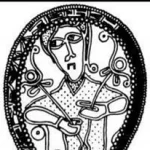Medieval Archaeology
Medieval Archaeology is our internationally-respected peer-reviewed journal. We publish two issues a year and members of the society receive a print copy as well as access to the online version.
I’m very pleased to announce that issue 68.2 of Medieval Archaeology has now been published online and the print copy should be arriving with members shortly. The content in this issue includes seven original articles focusing on new research from Britain, Ireland, the Netherlands, Sweden, Finland, Poland and Belgium covering both the early and late medieval periods.
The articles are followed by Medieval Britain and Ireland in 2023, which consists of the highlights of the Portable Antiquities Scheme and includes a research report on a rare pilgrim badge of St John Lateran, Rome. Finally, there are 19 book reviews of recent publications on medieval topics from across Europe, which will help readers keep up to date with the newest research in the field. I hope you all enjoy this volume and the editorial team look forward to bringing you the next one in the summer of 2025. This is my final issue for the journal, as Duncan Wright will be taking over as Editor with Katie Hemer as Deputy Editor.
Aleks Pluskowski, Honorary Editor of Medieval Archaeology
The current issue is Volume 68 No. 2, available online here.
Contributing to the Journal
The Honorary Editor welcomes original submissions of international significance, or national significance and international interest, which match the objectives of the Society. Information on submitting research articles and shorter contributions can be found on the How to Contribute page. For details of how to submit fieldwork summaries and highlights for publication, see the Medieval Britain and Ireland page. Please send books for review directly to the Reviews Editor.
The Society annually awards the Editor’s Award (formerly the Martyn Jope Award) of £300 for the best novel interpretation, application of analytical method or presentation of new findings published in its journal.
For information on rights and permissions, please read the instructions here.
Previous Volumes
Volumes 1 to 50 of our journal are now available free-of-charge online via ADS, while volumes 44 onwards are available online for our members at Taylor and Francis Online.
The Index to Volumes 51-55 of Medieval Archaeology is now available as a downloadable PDF.


